
Who says witches can only meet in the woods under the light of the full moon?
The COVID-19 Pandemic left many of us struggling to stay in touch with our communities. Without the ability to meet in person, we often found ourselves struggling to connect with each other. As National Novel Writing Month (NaNoWriMo) approached, a company of writers, many of them based out of Southern California, came together online in November of 2020 to support each other creatively). Through that community, several of us found we shared a passion for witchcraft and the supernatural.
So, we created a server on Discord, a digital coven as it were. Here was a safe space to talk about our relationships to the craft, dissect tarot readings, and offer support and community at a time when we all felt disconnected. Our digital coven allowed us to come together in a way we never would have been able to before.
Because, for our coven, storytelling and the occult go hand-in-hand, I asked some members to tell me their favorite tarot card so that I could recommend a book with similar themes. Combining the spiritual and fiction is something I am extremely passionate about, and I’m so excited to share these recommendations with you, too.
A good book can bring us together.
A good book can change the world.
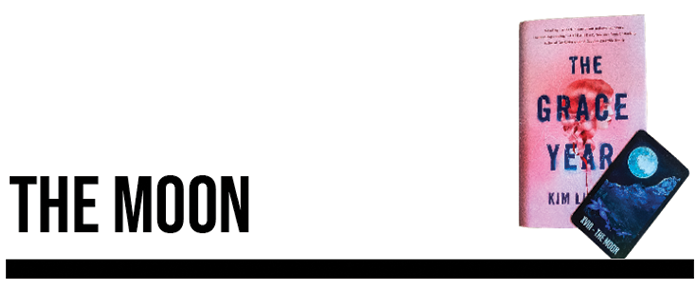
The eighteenth card in the tarot, the Moon, is about believing in illusions, feeling fear, or believing in a lie. When it comes up in a reading, it’s generally a sign to the reader that things are not as they appear. The light of the moon casts long, strange shadows that leave us confused and lost, chasing after things that aren’t there.
For this card, I’m recommending The Grace Year by Kim Ligget. The women of Garner County are told they have preternatural powers that lure men to sin, hurt other women, and otherwise cause harm to their community. At the age of sixteen, they’re sent to a special location for a year in order to dispel this power from their systems, making them safe for their respective communities. Tierney James is about to begin her year, but she quickly learns that nothing she once believed is as it seems.
This book is full of turns and shadows, things real and things imagined. If one were to give a tarot reading for Tierney, it would certainly have the Moon in it.
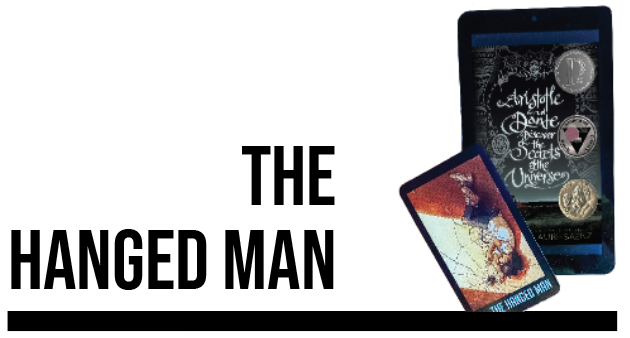
Of all of the cards in tarot, only The Hanged Man represents one specific figure. It is Odin, hanging himself from the Tree of Life in order to gain the secrets of the runes. In a spread, The Hanged Man tells the reader to let go of the burdens of their body, to sacrifice one’s self in order to live for self. You make a sacrifice of the old you so that the new you can thrive. It is my very favorite card in the entire deck.
Benjamin Alire Sáenz’s Aristotle and Dante Discover the Secrets of the Universe is a great book for others who, like me, feel drawn to this card. Aristotle is a young, quiet boy with a growing anger problem who feels unseen in the world. When a chance encounter with a boy, Dante, at the local pool leaves him with his first friend, Ari soon begins to question
everything about himself, his past, and his future.
Ari and Dante share a lot of parallels with The Hanged Man. Themes of discarding the way we’ve seen ourselves in the past in order to better know ourselves now. Sometimes the past is a weight or the future is terrifying, and the only way to face it is to let go. Ari, sometimes literally and sometimes figuratively, sacrifices himself to himself and to others, leading him to a more perfect understanding of himself and those around him.
Although this book stands perfectly on its own, it is made more fully a metaphor for the Hanged Man in the sequel, Aristotle and Dante Dive into the Waters of the World, which will be out in October of 2021.
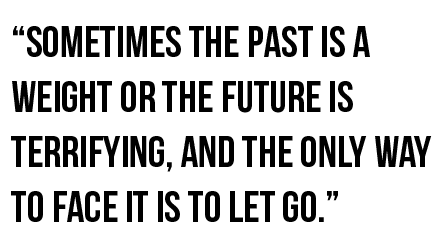
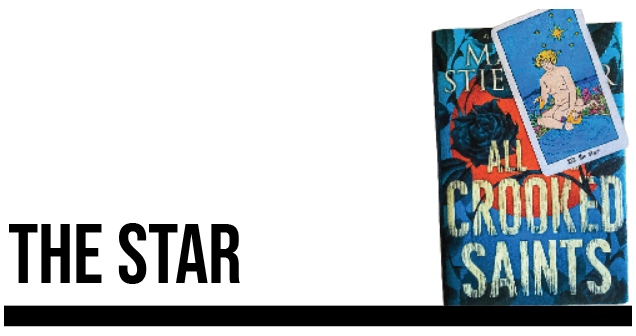
The Star is a symbol of hope. In readings, this card represents feeling serene, being inspired, and being generous. Sometimes this can indicate that you can expect hopeful, happy things to come your way, but frequently it is inviting you to share what you can. The Star lets you know that to give is sometimes better than receiving. Better yet, sometimes when you are generous with others, you are able to be generous with yourself.
The same themes in The Star can be found in Maggie Stiefvater’s stand-alone YA Speculative Fiction novel: All the Crooked Saints. Bicho Raro, Colorado is a place where miracles happen. The Soria family has, for generations, accepted pilgrims who come there seeking miracles and who discover upon arrival that to get a miracle, there is always a price to pay. Following three cousins, Beatriz, Daniel, and Joaquin, the story takes us into these miracles and the lives of everyone they touch.
What touches me most about this novel and the way it connects to the Star is how often the struggles of others impact the struggles of ourselves. The community in Bicho Raro is tightnit and insular. When one person suffers, everyone feels it. Throughout the course of the novel, the cousins learn that the opposite is also true: when one person prospers, when one person shares their hope, they all prosper. Joyful, heartfelt, and strange, this book will make you want to go to the mountains or desert and look up at the stars for hours.
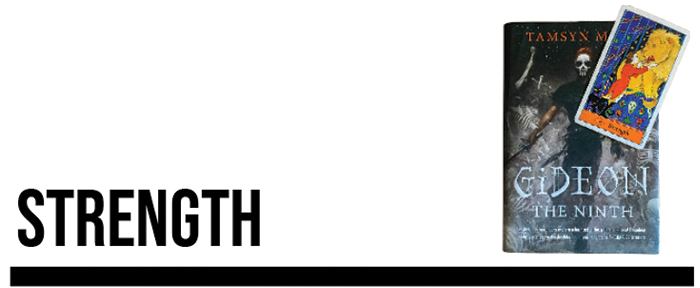
The Strength card traditionally depicts a person reaching into the jaws of a lion. This person is usually feminine with a saint-like countenance. This depiction is to show that strength, real strength, is not limited to physical power. It is also the power of compassion, of relating to others, of using what strength you have to help others. It is easy to fall back onto physical strength, but usually when this card appears in a reading, it is reminding the reader to exercise all their sources of strength, not just the physical.
I’m recommending Gideon the Ninth by Tamsyn Muir for this card. In an empire ruled by a necromancer, Gideon is one of the few living people in her home world. When an opportunity to finally leave the ninth planet presents itself, she travels with Harrowhark, the Reverend Daughter of the Ninth House and bone witch, to compete in a trial set by the emperor himself. Gideon is the sword to Harrowhark’s magic, but they both will have to find strength in each other and themselves if they are to survive.
Gideon is a strong heroine, ready to fight and stab her way out of her problems. Throughout the story, however, she learns to think her way through problems. She equally teaches Harrowhark that sometimes you don’t need a clever scheme, sometimes you just need muscle.
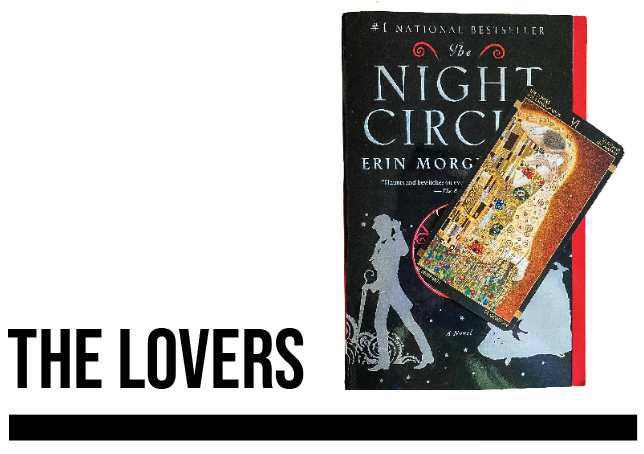
Most of us have a pretty firm idea of what The Lovers card means in a drawing. After all, it’s a pair of lovers —the meaning should be straightforward. Usually, however, this card is not an indicator of romantic or platonic love. Most of the time, The Lovers is about relating to others, discovering your values, and establishing personal beliefs. However, some decks do suggest that the card is about choosing between two options. Sometimes, decks will depict a man facing two women, one dressed in modest attire and one a little more revealing. He is making a choice between these women, but also about what kind of man he wishes to be. This exact meaning is the one that was asked for in regards to a recommendation.
When I tell you I am in love with The Night Circus by Erin Morgenstern, I am not being hyperbolic. I’ve read this book way too many times and own no less than three versions of it. The Night Circus follows two magicians, both adopted by powerful rivals, who have pitted the magicians against each other in a contest of magic that will, ultimately, leave one of them the winner and the other dead. The setting for this contest is a larger-than-life circus, and soon it draws in everyone involved in the circus, trapping them in this deadly game
I selected this book because Marco, the lead male character, has two women he is choosing from throughout the course of the story. In fact, all of the lead characters have choices to make throughout the book. The “this or that” theme plays into every plot point, with one choice knocking into another. There are also themes of determining values and relating to others, meaning that any version of The Lovers matches with this brilliant, speculative novel.
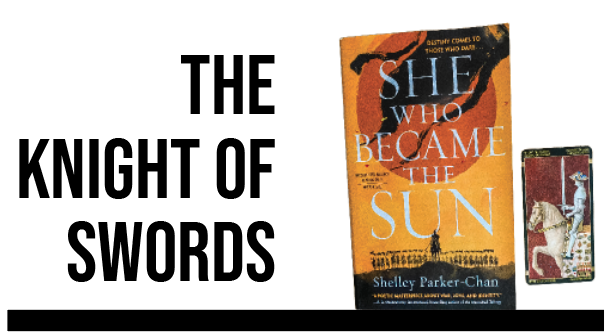
Swords as a suit represent the element of air. It is a logical suit with intellect and insight holding court. The Knight of Swords is direct, authoritative, logical, and knowledgeable. When The Knight shows up in a reading, it is usually to let you know these traits are needed. Often this card is seen as cold or unfeeling, when in reality it is simply that feelings are filtered through the lens of logic. You may have feelings but it is wisdom that should drive, not feelings. Feelings are not unimportant, but they do not control you. Only you control you.
She Who Became the Sun by Shelley Parker-Chan is an epic historical fantasy. It tells the story of Zhu, a young assigned-female-at-birth Chinese peasant who takes the name of her dead brother, dons his clothing, and becomes a monk in order to survive. Zhu knows that becoming her brother, in more than just name, is the only way to survive in the harsh world that surrounds her. Soon, fate will have her facing enemies and armies, and the fate of the world might rest on Zhu’s shoulders.
I love Zhu’s story as the Knight of Swords, because Zhu takes risks throughout the story but they are always calculated. Zhu relies on her mind as much as her body, and her intellect is what ultimately makes her the warrior she was always going to become. This story could carry many cards from the tarot, but Zhu’s story will always be that of the Knight of Swords.

Loving, tenderhearted, spiritual—these traits belong to the Queen of Cups. Water is the most emotional of elements and represents the ebb and flow of the heart, the high and low tides of our feelings. The Queen is a gentle figure, taming the waters with love and kindness. She holds the cup of life, letting it overflow generously. Her appearance in a reading often suggests that the reader allows themself to be loved and to love in return, even when that love might hurt or end, because it is the loving itself that matters.
The Mermaid’s Daughter by Ann Claycomb is a reimagining of Hans Christian Anderson’s The Little Mermaid with a modern, sapphic twist. Kathleen, a twenty-five year-old opera student, suffers from a rare condition that causes her feet to be in unspeakable pain if not submerged in sea water. She and her girlfriend Harry will travel to Ireland and back to learn the truth of Kathleen’s illness and the curse that took Kathleen’s mother.
Teeming with emotions, this story is perfect for the Queen of Cups, where water is used as a primary source of metaphor. Even when the story turns towards the sorrowful, there is always the water, the safety below its waves, calling the reader towards certainty, love, and comfort.

Wands represent the element of fire in the tarot, with all of its passion and creative force. It is easily the most creative of the suits, which makes The Queen of Wands the sovereign of creativity. Her card represents wit, experience, and honesty. When it comes up in a reading, it can be a source of encouragement, telling you that you are on the right path. However, it can also be a warning that while all these traits are positive, there are times when wit can harm while honesty can be cruel. Be careful, lest the fire burn you.
For The Queen of Wands, I’m recommending Pride by Ibi Zoboi, a modern retelling of Pride and Prejudice set in a rapidly gentrifying neighborhood in Brooklyn. Zuri, a young Afro-Latino teen, is proud of her family and her heritage. When the wealthy Darcy family moves into one of the new McMansions on the block, she quickly butts heads with Darius, who is arrogant and judgemental. But are they actually so different?
Zuri could absolutely sit on the throne of Wands. She is a gifted and creative young woman who is filled with a passion for the things and people in her life that matter. Sometimes that passion gets the better of her, resulting in pain for herself and others. Ultimately, though, she is able to harness her passion towards helping herself, her community, and the person she loves.
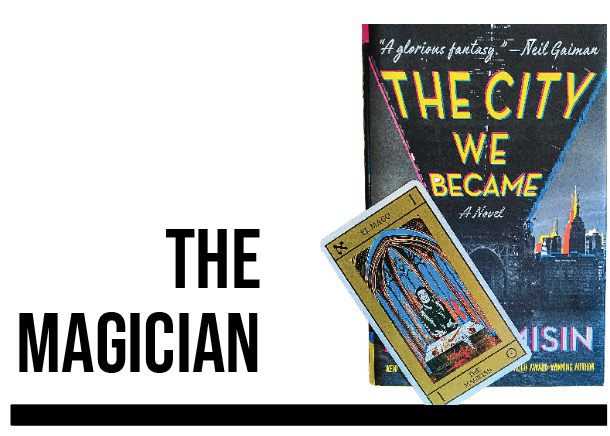
Although the number one is marked above the head of The Magician’s card, it is actually the second card in the deck. The Magician is a force of great creativity. In a reading, The Magician symbolises taking action, concentrating, and experiencing power. All the power of the universe is inside you, The Magician says. That power is yours to command, but make sure you do so from a place of purpose, from a place of growth, not from one of destruction and hate.
For my final recommendation, I’ve selected The City We Became by N.K. Jemisin, one of my all time favorite authors. Every city has a soul. When a city is itself enough, big enough and unique enough and a City enough, it takes on a human avatar, a house for the soul of the city. New York City is being born. Only it isn’t one soul. It’s five. Now five strangers from different boroughs must come together to defeat a relentless and hateful evil, or the city and everything in it will suffer.
I cannot say enough good things about this book. It is insightful, unique, and utterly captivating. Much like The Magician, it asks us to take control of our power, to find within ourselves the strength to turn our creative force into a force for good. Every one of these lead characters is a magician in their own right, but it is in coming together that they become The Magician singular, the power to wield the universe for good.
We all have that power in us. Sometimes all it takes is a spark, some small thing that changes how we look at the world, how we look at ourselves. With luck, that spark becomes a flame that changes ourselves and changes the world. x
